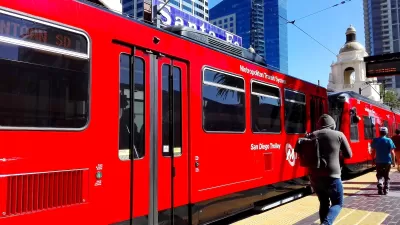Build it and they will come hasn't worked out so well for the Gillespie Field station on the Green Line of the San Diego Metropolitan Transit System. A recent scorecard rated the station lowest among 489 competitors.
Mark Srikishnan provides a case study of the worst rail station in the state of California—that dubious distinction courtesy of the metric produced by a report recently released by Next 10, which graded the state's 489 rail stations on their connection to their surrounding neighborhood.
The lowest scoring station of all 489 stations: the Gillespie Field trolley station, located in El Cajon on the Green Line of the San Diego Metropolitan Transit System. According to Srikishnan, the station is located near the county-owned Gillespie Field Airport, but not much else.
The isolation of the station did not fare well with the criteria of the study, described by Srikishnan: "There needed to be a high number of residents or employees in the surrounding areas who actually relied on public transportation. The station needed to be near amenities, like stores, banks and restaurants. It also needed to encourage walking with features like dense housing, sidewalks and cross-walks. The study also looked at home values, crime rates and any future plans for development in the transit areas."
So, for instance, the Gillespie Station earns a Walkscore of 32. Srikishnan also reports that development plans on the table in 1995, when the station originally opened, failed to materialize. Both CalTrans and the San Diego Association of Governments have targeted the Gillespie Field for growth, and "El Cajon recently submitted a proposal to SANDAG for funds to actually make some of these visions a reality."
FULL STORY: The Case of the Worst-Ranked Transit Station in California

Planetizen Federal Action Tracker
A weekly monitor of how Trump’s orders and actions are impacting planners and planning in America.

San Francisco's School District Spent $105M To Build Affordable Housing for Teachers — And That's Just the Beginning
SFUSD joins a growing list of school districts using their land holdings to address housing affordability challenges faced by their own employees.

The Tiny, Adorable $7,000 Car Turning Japan Onto EVs
The single seat Mibot charges from a regular plug as quickly as an iPad, and is about half the price of an average EV.

Seattle's Plan for Adopting Driverless Cars
Equity, safety, accessibility and affordability are front of mind as the city prepares for robotaxis and other autonomous vehicles.

As Trump Phases Out FEMA, Is It Time to Flee the Floodplains?
With less federal funding available for disaster relief efforts, the need to relocate at-risk communities is more urgent than ever.

With Protected Lanes, 460% More People Commute by Bike
For those needing more ammo, more data proving what we already knew is here.
Urban Design for Planners 1: Software Tools
This six-course series explores essential urban design concepts using open source software and equips planners with the tools they need to participate fully in the urban design process.
Planning for Universal Design
Learn the tools for implementing Universal Design in planning regulations.
Smith Gee Studio
City of Charlotte
City of Camden Redevelopment Agency
City of Astoria
Transportation Research & Education Center (TREC) at Portland State University
US High Speed Rail Association
City of Camden Redevelopment Agency
Municipality of Princeton (NJ)





























